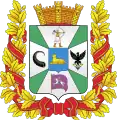Brahin, Belarus
Brahin (Belarusian: Брагін), Bragin (Russian: Брагин), or Brohin (Yiddish: בּראָהין) is a town in Belarus and an administrative center of Brahin Rajon. It stands on the banks of Braginka river, 28 km from the nearest railway (Chojniki station), and has a population of 3,700.
Brahin | |
|---|---|
| Belarusian: Брагін | |
 | |
 Flag  Coat of arms | |
 Brahin | |
| Coordinates: 51°47′N 30°16′E | |
| Country | |
| Voblast | Homiel |
| Raion | Brahin |
| Mentioned | 1147 (Hypatian Codex) |
| Population | |
| • Total | 3,700 |
| Time zone | UTC+2 (EET) |
| • Summer (DST) | UTC+3 (EEST) |
| Area code(s) | +375 02344 |
| Website | Брагинский районный исполнительный комитет (in Russian) — Brahin Rajon Executive Committee. |
History
The settlement is first mentioned in the Hypatian Codex in 1147[1] as the important town of the Kyiv princedom. A significant part of Brahin's population traditionally was of Jewish descent. By the end of 19th century, 2,254 of 4,311 inhabitants were Jewish.[2] During World War II, Brahin was under German occupation from 28 August 1941 to 23 November 1943. Many Jews in the area were killed by the German forces during that time:[3]
On September 13, 1941, the Jews of Bragin were ordered to gather in a school for the purposes of selecting a monitor and his deputy, but when 300 Jews came at the indicated time the school they were surrounded by Germans and closed. After that, Jews were led out in groups to the edge of the village and shot.
As a result of the Chernobyl disaster, areas of the Brahin district were radioactively contaminated. 52 settlements were resettled, 9 of which are buried. From Brahin itself 1,651 families (4,892 people) were resettled.
References
- Въ лѣто 6654 (1146) — въ лѣто 6655 (1147), ПСРЛ. — Т. 2. Ипатьевская летопись. — СПб., 1908. — Стлб. 327-360.
- "Raspredelenie naseleniya mest Rossiyskoy Imperii po chislennosti naseleniya. Vseobshchaya perepis’. Materialy ob economicheskom polozhenii evreev v Rossii.(1898) (ed. Evr.Kol.O-va), as cited on JewishGen website.
- "Ghettos in the Gomel Region: Commonalities and Unique Features, 1941-42" by Leonid Smilovitsky, Ph.D., Diaspora Research Center Lester and Sally Entin Faculty of the Humanities Tel Aviv University (fulltext); citing Yad Vashem Archives, collection M-33/1120, p. 5.
